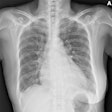The market for digital x-ray systems may have reached a tipping point in the U.S. in the past year, as the number of digital radiography (DR) systems being shipped has finally exceeded the number of conventional analog systems.

What's to account for the shift? Many larger facilities are realizing that having at least one DR unit onsite makes sense from a productivity standpoint. Also helping the situation is the growing number of imaging facilities with PACS networks installed, a necessary foundation for DR.
Computed radiography (CR) continues to enjoy brisk sales, with IMV estimating that some 1,700 readers will be sold in 2006 to U.S. hospitals (this number does not include non-hospital installations). Many facilities are installing both DR and CR, thanks to the latter's lower cost and versatility for portable studies and certain types of patient views not possible with DR.
At this year's RSNA meeting, look for DR vendors to continue to highlight new systems with improved functionality, in particular units with automated patient positioning systems that move into position at the touch of a button. Both CR and DR vendors are demonstrating applications for specialty orthopedic imaging of long bones and complete spines, with algorithms for stitching images together.
Disclosure notice: AuntMinnie.com is owned by IMV, Ltd.



















